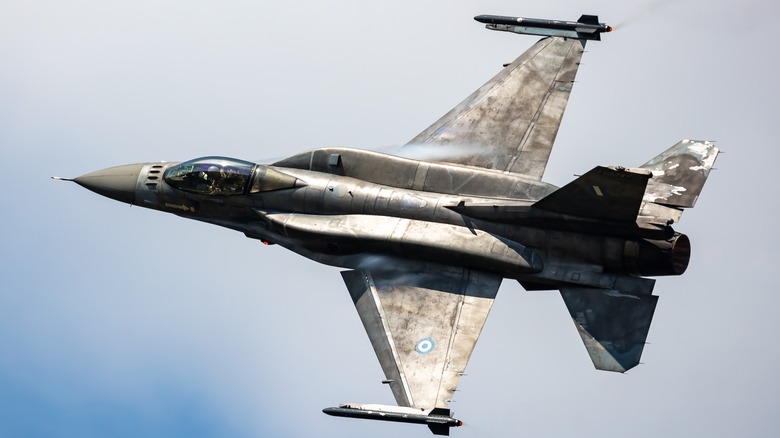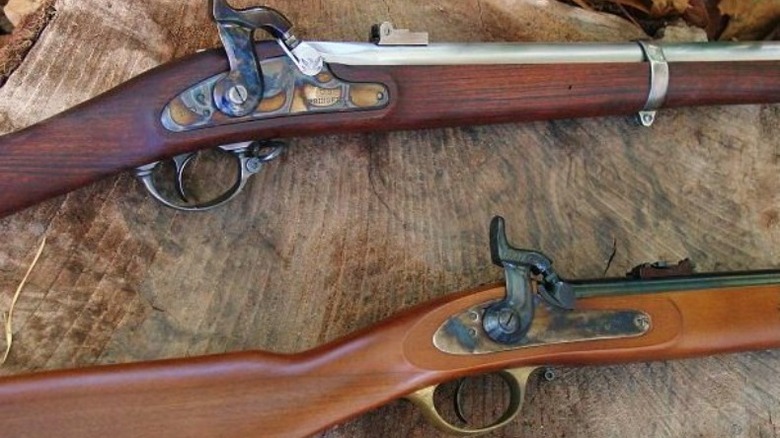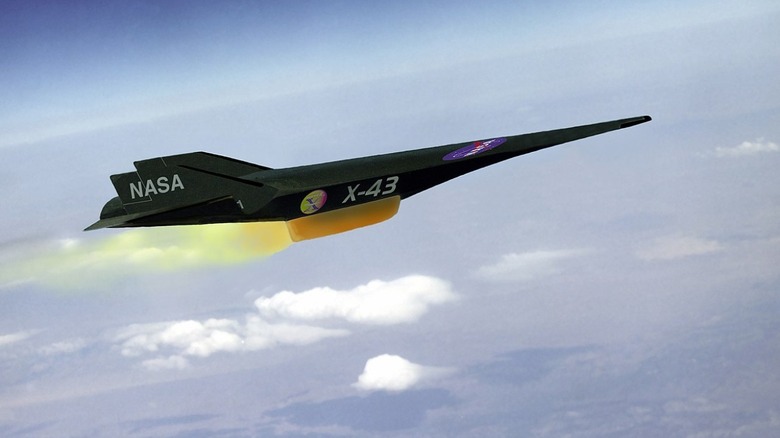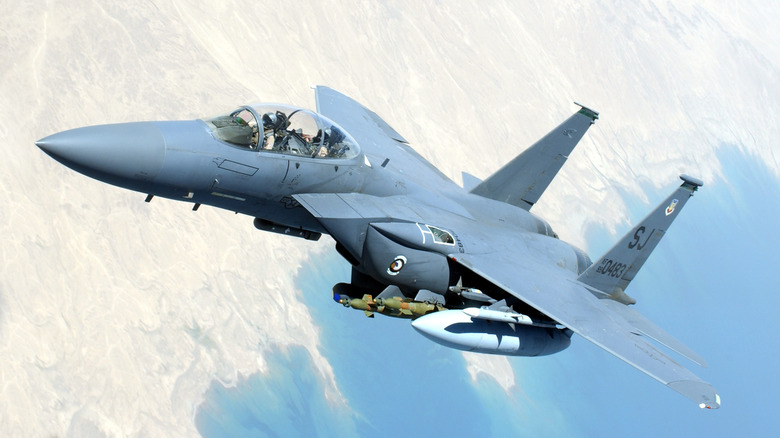Are Fighter Jets Faster Than Bullets? How Their Top Speeds Compare
"As fast as a bullet" is a common yardstick for something that's surprisingly speedy, and there are some others that immediately come to mind when we think of incredibly fast-moving things. Cheetahs, for instance. The Bugatti Chiron Super Sport 300+, one of the speediest vehicles ever made. Then, of course, there are fighter jets.
The comparison between the speed of bullets and that of fighter jets is a difficult one to make, because so much is dependent on the specific type of weapon/aircraft in question, as well as environmental and other factors that may be influencing their speed at a given moment. A 9mm Luger, according to Live Science, can fire bullets at approximately 1,360 mph, leaving them outrun by the top speeds of pacey jets like the United States' F-15E Strike Eagle (1,875 mph) and the Soviets' terrifying Mikoyan-Gurevich MiG-25, or Foxbat (capable of approximately 2,170 mph). The jets could not, however, keep pace with a conventional rifle shot, which can reach 2,727 mph.
The top speed of a conventional handgun, then, is slower than that of some of the fastest fighter jets, but not so with an equivalent rifle bullet. The contest, depending on your perspective, can be considered something of a draw: At the very peak of their possible pace, at the time of writing, both fighter jets and fired bullets have hit speeds up to around Mach 10, in very rare, extreme cases.
The evolution of the top speed of a bullet
The crucial thing to understand when determining the potential speed of a bullet is muzzle velocity. This is the speed at which a bullet is traveling when it leaves a gun. Some weapons that were used in the mid-to-late 19th century include the Enfield Pattern 1853, the Springfield Model 1861/63, and the Sharps rifle. The former two had muzzle velocities of 900 feet per second and 950 feet per second, while the Sharps considerably outperformed them on that score at 1,200 feet per second. These figures translate to approximately 613 mph, 648 mph, and 818 mph respectively.
Modern rifles have the capacity to far outdo this. In June 2024, Field & Stream's David E. Petzal declared the formidable .220 Swift to be one of the fastest rifle bullets around, noting that "my chosen load fired a 50-grain bullet at 3,900 fps and change. I recall that I could load 40-grainers to 4,300." 4,300 feet per second is the equivalent of approximately 2,932 mph, just short of Mach 4.
Electromagnetic railguns, unsurprisingly, utilize the power of electricity and magnetism to accelerate a projectile to even more astonishing speeds still. As retired Indian Lt. General Naresh Chand put it in SP's Naval Forces, "The building blocks of a Railgun are a pair of parallel conducting rails (one acts as positive and the other as negative conductor) and a sliding armature." An electric current passes through both rails, and the electromagnetic field blasts the shot to the end. Chandra concludes, "Antitank projectiles like armour-piercing fin-stabilised discarding-sabot can achieve a muzzle velocity (MV) of about Mach 5, but Rail guns can achieve a MV of Mach 7-10."
NASA's X-43, the mighty Mach 10 jet
Piloted fighter jets, as yet, haven't reached Mach 10. This could mean that, taken broadly, bullets are potentially faster overall than fighter jets. This requires two technicalities, however: That you consider a Mach 10 projectile from a railgun as a 'bullet,' and that you don't consider NASA's X-43 to be a 'fighter jet.'
If you really want to pull out all the stops, the fastest jet in history is – at present at least – NASA's X-43. Back in June 2013, NASA described the innovative model as being "powered by a revolutionary airframe-integrated supersonic-combustion ramjet or 'scramjet' engine," and boasted that it was targeting a remarkable speed of Mach 10 or thereabouts. As it was, it came very close indeed: Guinness World Records lists it as the fastest ever aircraft with an air-breathing engine, listing its speed as Mach 9.68 (the equivalent of 6,700 mph). The X-43, however, had no pilot and was strictly a limited experimental piece.
The X-43 machines were released by a B-52B at 40,000 feet for their historic flights, achieving both Mach 7 and (almost) Mach 10. Their journey was very brief, though, at approximately ten minutes in both cases. This is another interesting element of the question of bullet vs fighter jet top speeds: The different constraints upon each and the fact that, ultimately, neither will be traveling at their very, very fastest for long, and certainly not very often.
Practical fighter jets in operation
After ten minutes in Mach 7+ action, then, having gathered all the information they were intended to, NASA's record-setting X-43 jets arrived at their final destination: Under the surface of the waters off the California coast. The fact that it covered 850 miles in those ten minutes highlights just one reason that it's impractical for any kind of jet to travel at its very top speed outside of rare and specific instances.
Another is the fact that, for a conventional fighter jet, achieving top speed tends to require afterburners, and peak speeds mean peak fuel use. The afterburner offers a huge boost of thrust when needed, but is very impractical to use for extended periods because it sacrifices fuel efficiency for it, making it very wasteful in that sense. Nonetheless, the pace fighter jets are capable of, even for brief periods, is no less blistering for that.
Just as fighter jets spend very limited time at their very top speeds, so too can bullets. As Virginia Commonwealth University forensic scientist Stephanie Walcott explained to Live Science, "it doesn't take long before gravity and air drag really start setting in and slowing that bullet down ... it's going to start dropping off and becoming sensitive to the environment around it." Gravity and drag from the air mean that the speed of a bullet in motion will vary enormously, as will the speed of a fighter jet depending on the situation. Ultimately, though, there are jets that can outspeed the vast majority of bullets and bullets that can outspeed almost all jets.



